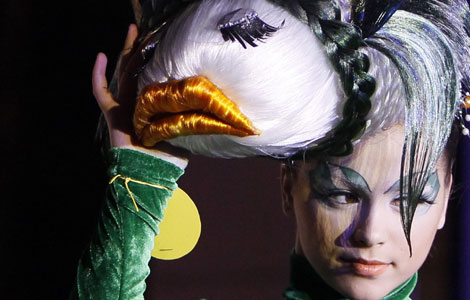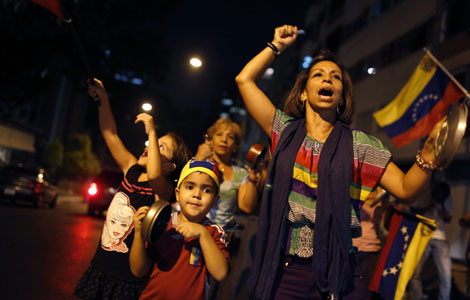Terracotta Warriors exhibit to open in US
Updated: 2013-02-22 01:39
By CHEN YINGQUN (China Daily)
|
||||||||
Ten life-sized Terracotta Warriors from China will be a central part of an exhibition in San Francisco that opens on Friday.
The exhibition, China's Terracotta Warriors: The First Emperor's Legacy, commemorates the 10th anniversary of the Asian Art Museum. It is the first exhibition held in the United States that focuses on the historical relics of China's Qin Dynasty (221-206 BC).
 |
|
A man clad as a Terracotta Warrior draws visitors' attention to the first major US exhibition of relics of the Qin Dynasty (221-206 BC), held in San Francisco on Wednesday. [Photo by Chen Gang / China News Service] |
In a bid to achieve immortality, China's first emperor Qinshihuang of the Qin Dynasty built himself a tomb — a vast underground city guarded by a life-sized terracotta army including warriors, infantrymen, horses, chariots and all their attendant armor and weaponry, said He Li, curator of the exhibition.
The underground burial complex was first unearthed in 1974 in Shaanxi province, and is considered an astonishing discovery on a par with ancient Egypt's elaborate tombs.
He said 123 exhibits from Qinshihuang's tomb and tombs of the early Qin Dynasty sent by 13 museums in Shaanxi will be on display. The exhibition will feature 10 figures — a representative sample of the actual army, which is estimated to include more than 7,000 life-sized figures and more than 10,000 weapons.
Visitors will be able to take a close look at the first emperor's other relics, such as the bronze swords inlaid with gold and turquoise and horses and chariots, said Jay Xu, the executive director of the Asian Art Museum.
Chang Lei, a historical relic protectionist of Emperor Qinshihuang's Mausoleum Site Museum of Shaanxi province, told China News Service that this exhibition is distinctive, as they have brought to the US the terracotta warriors with the most dramatic look, the earliest discovered cavalry figurine and the rare kneeling terracotta warrior with his face painted green.
The chariot and horse terracotta displayed in the hall of the museum are also unusual.
"Usually we only showcase one of them. This time, we are displaying both, which is unusual," Chang said.
To prevent the exhibits from being damaged in earthquakes, which can occur in San Francisco, the Asian Art Museum has made every exhibit shockproof. They have also used 3-D image technology and drawings to reproduce the images of the weapons, horses and other items from the Qin Dynasty to help visitors better understand the ancient culture of the period.
A "Lost Warrior" campaign was launched two weeks ago to promote the exhibition. The museum asked a local actor to dress like a terracotta warrior and appear in at least 50 places across the city. The city's residents were invited to track his whereabouts and put his photo on social media to win free passes to the exhibition.

 Li Na on Time cover, makes influential 100 list
Li Na on Time cover, makes influential 100 list
 FBI releases photos of 2 Boston bombings suspects
FBI releases photos of 2 Boston bombings suspects
 World's wackiest hairstyles
World's wackiest hairstyles
 Sandstorms strike Northwest China
Sandstorms strike Northwest China
 Never-seen photos of Madonna on display
Never-seen photos of Madonna on display
 H7N9 outbreak linked to waterfowl migration
H7N9 outbreak linked to waterfowl migration
 Dozens feared dead in Texas plant blast
Dozens feared dead in Texas plant blast
 Venezuelan court rules out manual votes counting
Venezuelan court rules out manual votes counting
Most Viewed
Editor's Picks

|

|

|

|

|

|
Today's Top News
Live report: 7.0-magnitude quake hits Sichuan, heavy casualties feared
Boston suspect cornered on boat
Cross-talk artist helps to spread the word
'Green' awareness levels drop in Beijing
Palace Museum spruces up
First couple on Time's list of most influential
H7N9 flu transmission studied
Trading channels 'need to broaden'
US Weekly

|

|







